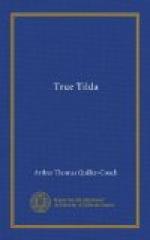“You,” he said. “You—and everything.”
“Of all the queer boys—” she began, and broke off with a catch of the breath. “Hulloa!”
The boy looked up to see her eyes fixed, round and wide, on his naked shoulder.
“What’s that mark you got there?” she demanded.
“This?” He put up a hand to a pattern of four diamonds joined in a horizontal line. “I don’t know. I’ve wondered sometimes—”
“But you must ’ave come by it some’ow. Can’t you remember?”
He shook his head.
“It has been there always. And yet I couldn’t have been born with it.”
“’Course yer couldn’,” she agreed
The mark was pencilled in thin lines of red a little below the right shoulder, across the width of the deltoid muscle, and in figures about half an inch tall. “’Course yer couldn’,” she repeated. “That’s tattooin’, if ever there was tattooin’; an’, what’s more,” she went on, nodding her head with great positiveness, “I know who done it, leastways I know part of ’is name . . . Don’t stare, now; lemme think . . . Yes, it’s plain as plain. ‘Four di’monds,’ she said; an’ di’monds they are, same as on a pack o’ cards—me all the time thinkin’ of them as the ladies wear on their fingers. But ‘on his coat,’ she said; nothin’ about yer shoulder.”
“‘She’? Who was ’she’?” asked the boy. “Never you mind,” said Tilda hurriedly. “But him as done it was called Ned. Now try to think if you ever came across a party as was called Ned?”
“There was a boy called Ned at Holy Innocents; but he died in the time we all had sore throats—and, besides, he was the youngest of us. I don’t remember any other.”
“Any sailor-man, then? It’s mostly sailors that know about tattooin’.”
“Oh, yes,” he answered promptly, to her surprise. “There were lots of sailors—five or six, I think. They had long glasses, and used to watch the sea. And one played music on a thing that went so.”
He brought his hands together, drew them wide, and brought them together again—the palms open.
“That would be a concertina,” nodded Tilda, “or elst an accordion. Now try to think, becos’ all this is very important . . . Where was this place? and what like was it?”
He considered for a while, frowning to help his memory.
“There was a line of white houses, and one had red flowers in the window . . . and a pole, with flags on it . . . and ships passing . . . and from the houses a path went down to the sea. I remember quite well what it was like down there . . . with waves coming in, but not reaching to us, and sand where I played, and rocks, and pools full of shells and brown flowers. There were shells, too, on the rocks, with live things inside—though they never moved. I don’t think I knew their name; but I know it now. They were called ‘scammels.’”
“I’ve ate limpets,” said Tilda; “limpets an’ whelks. But I never ’eard o’ scammels. An’ you don’t remember the name o’ this place?”




